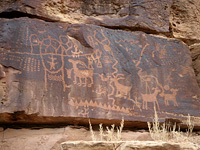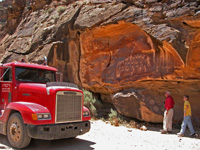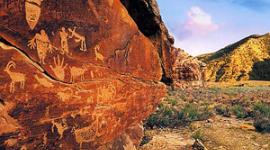Nine Mile Canyon

Nine Mile Canyon in Central Utah may not be as well known as other public lands in the West, but there is no denying its cultural significance.
Site of thousands of prehistoric Native American rock art panels that have earned it the moniker “the world’s longest art gallery,” Nine Mile Canyon boasts the densest collection of such panels in the United States. But the petroglyphs and pictographs attributed to the Archaic, Fremont and Ute people are not the canyon’s only claims to a piece of American history. The canyon also contains many historic sites – including stagecoach stations, settlers’ cabins, ranches, and iron telegraph poles installed by the famed 19th-century Buffalo Soldiers – that stand as reminders of the area’s more recent, pioneer history.
But in addition to its cultural treasure of global significance, Nine Mile Canyon also contains vast reserves of natural gas—reserves that have invited the attention of energy companies, and framed the basic challenge at Nine Mile: How to extract natural gas without inflicting irreparable harm to the canyon’s cultural resources?
The primary threat to the canyon’s fragile treasures comes chiefly not from the drilling itself, but rather from the hundreds of heavy trucks that traverse the canyon’s narrow, unpaved roads on a weekly basis. Heavy truck traffic through the canyon churns up clouds of dust, coating the rock art images with a layer of corrosive grime. In an attempt to mitigate the harmful effects of the dust, energy companies have used a chemical dust suppressant—magnesium chloride—that is likely to harm cultural resources in Nine Mile.
In fact, a Draft Environmental Impact Statement (DEIS) issued earlier this year by the Bureau of Land Management (BLM) confirmed that dust generated from truck traffic damages the rock art, and a scientific report issued subsequent to the DEIS found magnesium chloride at the Great Hunt Scene, one of most significant rock art panels in the canyon. Magnesium chloride is “notorious for its deleterious effects on cultural property,” according to the rock art conservator hired to work on the DEIS.
Now, the BLM, the federal agency responsible for stewardship of Nine Mile Canyon, is proposing to increase the amount of drilling—and, in turn, the number of trucks traversing the canyon—by offering for sale an additional 16 new oil and gas leases in the area around the canyon. The sale is scheduled to take place on Friday, December 19th. The National Trust for Historic Preservation, joined by several environmental groups, announced this week that they are filing a lawsuit seeking to prevent the BLM from going forward with the sale.

At a press event held on Wednesday, December 17 th Congressman Brian Baird (D-Wash) blasted the outgoing Administration’s plans to further open up Nine Mile Canyon and other wilderness areas to increased drilling. “This sale is an early Christmas present to the oil and gas industry, from a lame duck administration with one foot already out the door,” said Congressman Baird. “The way the Bush administration has tried to do this in secret is simply outrageous.”
Richard Moe, president of the National Trust for Historic Preservation, also noted that “we included Nine Mile Canyon on the list of America's 11 Most Endangered Historic Places [in 2004] because it is being damaged, perhaps permanently, by oil and gas drilling-related truck traffic near the canyon. BLM agrees that dust and chemicals from the traffic are damaging this fragile place, which makes its decision to approve even more leases -- and more truck traffic -- bewildering.”
Also bewildering to those who care about Nine Mile Canyon is the BLM’s unwillingness to consider a solution that would allow energy companies to access the canyon’s natural gas reserves while inflicting minimal harm to its cultural resources. The National Trust for Historic Preservation recently commissioned an engineering study that examined alternate roadways through the canyon—roads that would allow full access to natural gas reserves while avoiding most of the canyon’s rock art.
Happily, the results offer a way for both sides to get what they want: The study concludes that alternative access routes to natural gas are feasible from an engineering standpoint. By moving the heavy trucks away from cultural resources, the energy companies would be able to get what they want—natural gas—while at the same time sparing cultural resources from further damage.
Astonishingly, however, the BLM has refused to consider these alternative access routes in its environmental evaluation of the energy companies’ proposals. This recalcitrance is especially baffling in light of BLM’s own finding that Nine Mile Canyon contains the highest density of rock art in the United States. On one hand, the Bureau recognizes that the canyon is rich in irreplaceable cultural resources that are being harmed by traffic-related dust and chemicals – but on the other hand, it refuses to study the alternative access routes that would preserve the canyon’s most sacred treasures. These contradictory positions make no sense.


Nine Mile Cayon Rock Art and Hunting Scenes, Utah; Nine Mile Canyon Oval Panel, Utah. Copyright © National Trust for Historic Preservation
The National Trust for Historic Preservation does not want to stop energy extraction altogether, but simply wants BLM to conduct a new environmental evaluation that officially and fully considers alternative access routes that could halt the destruction of cultural treasures for which the Bureau is responsible.
We don’t have to choose between meeting the country’s energy needs and protecting our heritage. At Nine Mile Canyon, we can – and must – do both.
How to Help
Individuals interested in showing their support can write a letter to their congressional representatives.




